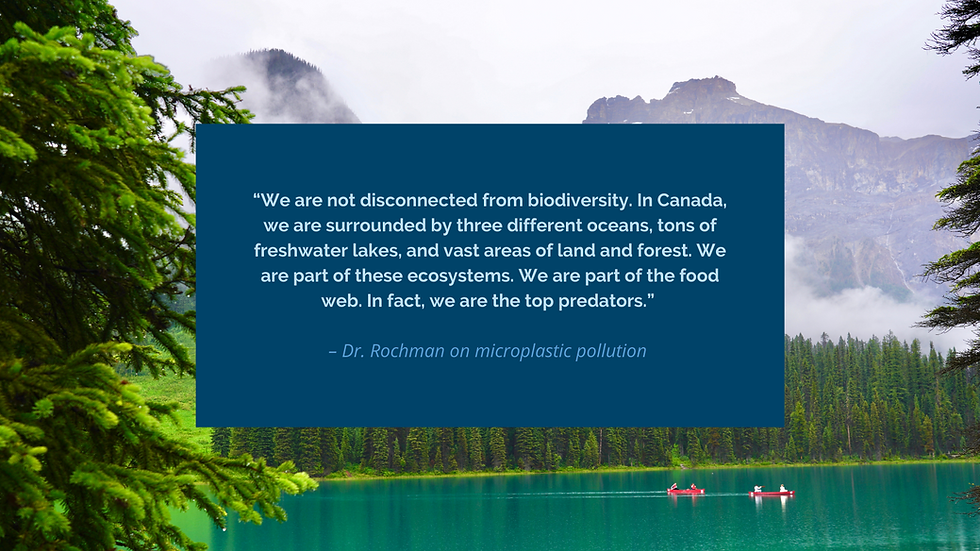Unpacking the Microplastic Pollution Problem in Canada
How microplastic pollution affects Canadians, what is being done, and how you can make an impact
Microplastics, pieces of plastic 5mm and smaller, have been found in all of Earth’s environments, including our oceans, lakes and rivers, soil, air, drinking water and even our bodies. With approximately 13 million square kilometres of land and water and almost 20% of the planet's wilderness.
“In Canada, we are surrounded by three different oceans, tons of freshwater lakes, and vast areas of land and forest. We are part of these ecosystems. We are part of the food web. In fact, we are the top predators." - Dr. Rochman.
Dr. Chelsea Rochman, international microplastics expert and head of the Rochman Lab at the University of Toronto joined us for an interview to discuss microplastic pollution in Canada and what we can do about it. “In Canada, we are surrounded by three different oceans, tons of freshwater lakes, and vast areas of land and forest. We are part of these ecosystems. We are part of the food web. In fact, we are the top predators,” explains Dr. Rochman.
The scientific literature demonstrates that microplastics have infiltrated nearly every level of global food webs, found in the smallest ocean animals to the biggest top predators. The impacts could change the ecosystem structure and our food security.

So how do microplastics enter our waters and food chains? Major contributors include plastic microfibers from our clothing that are released in our household wastewater from our washing machines, car tire particles that enter our air and nearby waterways, and litter that breaks down into smaller pieces of plastic.
“I’ve seen Canada adopt a lot of strategies from international agreements, banning single-use plastics at a federal level, and committing money to help developing countries adopt new waste management strategies,” says Dr. Rochman. She illustrates that Canada can make a big impact, leading by example and providing resources and lessons learned to other sister countries. Of course, we are not without our own issues.
“Our waste management may appear seamless on the surface, and we certainly can be proud of how far we’ve come, but we still have room for improvement.” Dr. Rochman notes that areas in the north of Canada still lack sufficient waste management infrastructure and often the solution to plastic waste is to send it across borders. Many developed countries send their plastic waste to developing nations. You may be walking around a beach overseas and stumbling upon waste from your own country.
"…only 9% of plastics produced is being recycled…" - Dr. Rochman.
"99% of our plastic is either shipped overseas, recycled, or sent to the landfill…only 9% of plastics produced is being recycled…the rest is sent to landfill, overseas or into the environment,” Dr. Rochman illustrates. “We have a lot of work to do on our own soil. We are not off the hook.”
In the United States, California has made headway on several sources of plastic pollution, including microfiber pollution by proposing a bill that requires washing machines owned by the state to have a microfiber filter installed before Jan 1, 2022. The State also has legislation asking for answers to the following questions: How do we define microplastics in drinking water and the environment? What are the methods to quantify and characterize it? How much is too much? Can we put a risk threshold on it?
Dr. Rochman has been at the table during these conversations in California and sees relevance in Canada. “We can learn from this and create risk assessments for microplastics here in Canada,” encourages Dr. Rochman. Her lab and the U of T Trash Team are doing just that by investigating the impacts of microplastics on aquatic animals, looking at how microplastics move through food webs, and identifying solutions.
“Individuals can 100% make an impact, and we need impact at every level” - Dr. Rochman.
When it comes to impact, the public cannot be overlooked. “Individuals can 100% make an impact, and we need impact at every level,” reassures Dr. Rochman.
She left us with 3 easy takeaways with big impacts.
1. Understand where your plastic waste goes, what can actually be recycled in your community, and what cannot be. Your municipality’s website is a good place to start.
2. Avoid unnecessary single-use plastics.
3. Write your Member of Parliament (MP). Decision-makers care what citizens care about, so tell them you care about plastic pollution. Here are some tips on how to write to your municipality.
To learn more about microplastic pollution in Canada and how you can get involved, join the conversation using the hashtag #BeatPlasticPollution.
About Ocean Diagnostics: Ocean Diagnostics Inc. (ODI) is a Victoria, B.C.-based environmental impact company that diagnoses and protects our planet from the threats of plastic pollution and biodiversity loss. Through innovative technology, cutting-edge laboratory capabilities and scientific experts, ODI enables scientists and the public to collect the data needed to influence local and global solutions.
